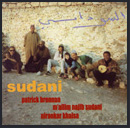













 |
|
|
Patrick Brennan, Najib Sudani, Nirankar
Khalsa:
SUDANI Deep Dish DD-104,
1999
“Out of the desert resumed the blowing of the almost
unbreathable sirocco, and it would have been 95 degrees in the shade if the
light hadn’t decided to fill all of Rue Oujdan, driving the foreigner
to take refuge in the little shop of M’allim Sudani. The Moroccan, though
surprised by the appearance of the unexpected silhouette, calmly rises to
greet the figure looming between the light and the shade of the
boutique...”
...the encounter might not have occurred exactly like this, but the truth
is that Najib Sudani and Patrick Brennan met by mere chance, and even though
they didn’t speak the same language, they managed to establish a close
collaboration based on the reciprocal understanding of each other’s
musical language.
How is it that a m’allim of Gnawa music, which came from the Sudan over
4oo years ago via slavery, and a North American composer/improviser have
managed to articulate a coherent musical discourse? The answer has to be
found in the defiance of limits: both are innovators within their respective
cultural traditions.
Although contemporary jazz has carried its African heritage into previously
unsuspected sonic regions, it’s never forgotten its roots, periodically
striving to reinterpret them and adapting them to actual circumstances. And,
it’s in this context that Patrick Brennan meets Najib Sudani, who in
turn emerges as a musician who, in seeking to liberate himself from the
conventions of his own medium, explores new forms of expression. It’s
not therefore by accident that Sudani’s guinbri doesn’t have the
usual tuning for this instrument, therefore raising some misunderstanding
as far as the people from his homeland are concerned. It’s also not
by chance that the range of timbres used by Patrick Brennan goes beyond
what’s usual for the alto saxophone. As masters of musical creation,
both look to transcend the limitations of their respective cultures. Perhaps
this might be the common denominator that confers cohesion to this
soundscape.
There’s still a third element that contributes significantly to the
recording’s groove: Nirankar Khalsa. A Chicago percussionist who quite
readily talks about an Indian tintal rhythm he plays as percussionist during
Gypsy celebrations (you just have to go to Madrid to hear him play). Neverthless,
it’s with his voice and flute that he invokes the ancestral spirit of
the Blues.
- Abdul Moimeme
FLIRT MAGAZINE July 20, 2000 page 29
“Do deserto voltou a soprar o quase
irrespir<vel siroco, e estariam 35 graus B sombra se a luz nno tivesse
decidido inundar toda a Rue Oujdan obrigando o foresteiro a tomar refugio
na pequena loja de ‘m’allim’ Sudani. O Marroquino, embora
supreendido pela apariHno da inesperada silhueta, levante-se tranquilamente
para cumprimentar a figura que se assoma entre a luz e a sombra da
loja...”
...o encontro pode nno ter ocorrido exactamente assim mas a verdade J que
Najib Sudani e Patrick Brennan encontrarem-se por mero acaso, e embora nno
falassem o mesmo idioma conseguirem establecer una estreita colaboraHno baseada
na compreenHno reciproca das respectivas tradiHtes culturais.
Como J que um ‘m’allim’ da musica Gnawa, vinda a Sudno B mais
de 400 anos por via da escravtura, e um compositor/improvisador norte-americano
conseguem articular um discurso musical coerente? A resposta tem de ser
encontrada no desafio dos limites: ambos sno inovadores dentro das suas
respectivas tradiHtes culturais.
Assim, embora o jazz contempor>neo tenha levado a sua heranHa africana
a regites sonoras insuspeit<veis, nunca esqueceu as suas origems, procurando
periodicamente reinterprit<-las, adaptando-as Bs circunst>ncias actuais.
I neste contexto que o Patrick Brennan se confronta com Najib Sudani que
por sua vez surge como um musico que, procurando libertar-se das convenHtes
do seu meio, explora novas formas de expressno. Nno J entno por acaso que
o ‘guinbri’ de Sudani nno tem a afinaHno usual para este instrumento,
o que por sua vez leva alguma incompreenHno por parte dos deus contemporaneos.
Tambem nno J por acaso que a gama de timbres usada pelo Patrick Brennan
transborda aquela que J usual para o saxophone alto. Como mestres da criaHno
musical ambos procuram transcender as limitaHtes das suas respectivas culturas.
Talvez seja esse o denominador comun que confere coesno a este registo
sonoro.
sudani
Existe ainda um terceiro elemento que contribui significamente para o
‘groove’ da gravaHno: trata-se de Nirankar Khalsa. Um percussionista
de Chicago que fala tno a vontade de um ritmo ‘tintal’ indiano
como toca percussno em plena festa cigana (J s\ ir a Madrid ouvi-lo a tocar).
Contudo J com a voz e flauta que ele invoca o espRrito ancestral dos
‘Blues’.
|
|


 www.flirt.ip.pt
www.flirt.ip.pt